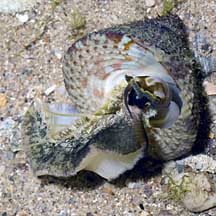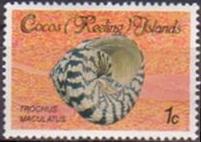 |
| from: wildsingapore.com |
Table of Contents
Scientific name: Trochus maculatus Linnaeus 1758
Common names: Maculated Top Shell, Spotted Top Shell Snail
Etymology: The species epithet refers to the snail's maculated (spoted) shell
Synonyms:
| Trochus maculatus |
Linnaeus, 1758 |
accepted name |
| Trochus stellatus |
(non Gmelin, 1791) |
misapplied name |
| Tectus maculatus |
Linnaeus, 1758 |
synonym |
| Trochus verrucosus |
Gmelin, 1791 |
synonym |
Biology
| Sentosa rocky shore where they can be found |
Habitat
General: Coral rubble, rocky habitat.
From low in the intertidal zone to a depth of about 10m.
In Singapore: T. maculatus is found mostly in crevices in seawalls, stones and large boulders, usually alone. Shores where they have been found include East Coast, Labrador, Pulau Sekudu, St John's Island, Lazarus Island, Kusu Island, Sisters Island, Pulau Hantu and Pulau Semakau, Tanah Merah, Sentosa and Cyrene Reef.
Feeding
This species is a non-selective grazer and is considered to be a nocturnal feeder. It feeds on macrophytes, blue-green algae and benthic diatoms. Things common in its diet include green alga (Enteromorpha sp.), red alga (Hidenbrandtia sp.), and benthic diatoms (Navicula sp. and Nitzchia sp.) T. maculatus is not a picky eater and will consume other food when its preferred food is unavailable (Thapanand et al, 1995). A study has found that moderate disturbance in terms of freshwater runoff and ecologically relevant amounts of the heavy metal copper can reduce grazing activity by T. maculatus without a corresponding decrease in macro-algae production (Elfwing and Tedengren, 2002). Grazing helps to maintain low macroalgal standing crops in the tropics, and such a reduction in herbivory can result in phase shifts, where large and fleshy macroalgae increases at the expense of hard coral cover (Done, 1992; Hughes 1994).
Reproduction
Separate sexes, external fertilization. Eggs are laid singly in seawater and hatched as free-swimming planktonic larvae, or bound in gelatinous masses and then frequently hatching as crawling juvelines (Rome, 1998). Fertilized eggs metamorphose into the creeping stage within 7 days and can be observed by the naked eye within a month. T. maculatus can only spawn in the new moon period and may be induced to do so using thermal shock (Chunhabundit et al, 1994).
Commercial Value & Significance
Food
Collected for its edible flesh and nacreous shell in Japan and Philippines and other Southeast Asian countries.
Craft/Decorative
Shells are utilized by shellcraft industries, sometimes serving as mother-of-pearl or as lime material.
| A website selling T. maculatus shells |
Stamps
T. maculatus is featured on a 1985 stamp from the Cocos Islands (Keeling Islands):

(image from stamp-gallery)
Distribution
T. maculatus is widespread in the Indo-West Pacific, from East Africa to Melanesia; north to Japan. and south to Southern Queensland and New Caledonia. Here is a map showing the distribution (Rome,1998):
Taxonavigation
This information is provided to allow you to search for more general information on the upper hierarchical taxa (groupings) that T. maculatus belongs to.Kingdom: Animalia
Phylum: Mollusca
Class: Gastropoda
Subclass: Vetigastropoda
Superfamily: Trochoidea
Family: Trochidae
Subfamily: Trochinae
Genus: Trochus
Diagnosis
Want to know for sure that the snail you're staring at on a rocky shore is T. maculatus? Here are some simple pointers on how to distinguish T. maculatus from other similar Trochidae species. (images from Rome, 1998)
- Umbilicus is present. Should not be confused with members of the genus Tectus, which have no umbilicus.
- Columella is dentate. Should not be confused with Trochus conus, which has a smooth columella.
- May be distinguished by the axial streaks on its shell and base with radiating streaks or spots. Should not be confused with Trochus hanleyanus which has fine axial lines on its shell and base with numerous, crowded and wavy radiating lines.
Description
Shell Structure
- Shell medium sized (up to 7 cm long), thick and solid, highly variable, conical in shape, about as wide as long to markedly longer.
- Spire tall, often strongly narrowed in its upper part and with pointed apex, whorls either concave, flat or convexly bulging, their sides covered with numerous spiral rows of irregularly sized granules (usually 6 to 8 per whorl).
- Granules either rounded and separated or laterally compressed, like axial folds, giving occasionally short axial ribs at the otherwise rather shallow sutures.
- Periphery of body whorl acutely
rounded. - Base of shell flat, with many low
and finely beaded spiral threads. - Umbilicus present, spirally
corded. - Aperture roughly quadrate to
subtrigonal.
- Outer lip strongly oblique above periphery, delicately lirate inside.
- Columella with 4 to 5 low spiral cords, giving its margin a multi-dentate aspect.
(Rome, 1998)
Colour
- Outside of shell extremely variable, usually whitish with roughly axial stripes or blotches of deep red, purple, or brown, with the stripes occupying more space than the ground colour or vice-versa.
- Stripes radiating, often narrower, discontinuous and somewhat lighter coloured on the base.
- Umbilicus area and columella nacreous.
- Shell often covered in algae and other encrusting organisms.
Phylogenetic Position
Here are the resulting phylogenetic trees from 2 studies that have included T. maculatus.
A molecular phylogeny by Williams et al. (2010) for Trochidae and Calliostomatidae based on analysis of concatenated sequences from four genes (28S rRNA, 12S rRNA, 16S rRNA and COI) produced by Bayesian analysis incorporating an uncorrelated relaxed, lognormal clock using BEAST. All taxa for which sequence was available for both 28S rRNA and at least two mitochondrial genes were included. Tree is a maximum clade credibility tree with median node height based on 67,500 trees. Support values are posterior probabilities (PP) (only shown where PP > 50%). All trochid subfamilies were recovered as monophyletic groups as indicated by grey boxes and are labelled on the right in grey text. No scale bar is provided because the root was arbitrarily set to one, and all other branch lengths are relative. Species names used in trees are ‘traditional’ names and do not reflect changes to taxonomy suggested by this study.
Below is a Wagner tree illustrating the hypothetical phylogenetic relationships among 6 taxa from the genera Trochus and Tectus. Total tree distance was 2.419 (Borsa and Benzie, 1993).
Genome Information
Here are some links to databases providing sequences for phylogenetic studies and other uses:Nucleotide (14)
Protein (5)
PopSet (7)
Taxonomy (1)
Comments
If you have any suggestions or comments, please feel free to start a discussion under the 'Discussion' tab at the top of this page. All comments will appear in this section. Alternatively, you may directly click on a post below to reply to it.
| Subject | Author | Replies | Views | Last Message |
|---|---|---|---|---|
| First Comment | 0 | 139 |
Nov 15, 2011 by |
References
Borsa, P., Benzie, J.A.H. (1993) Genetic relationships among the topshells Trochus and Tectus (Prosobranchia, Trochidae) from the great-barrier reef. Journal of Molluscan Studies Vol 59, p275-284 doi: 10.1093/mollus/59.3.275
Chunhabundit, S., Thapanand, T. (1994) Some culture techniques of topshell Trochus maculatus L. Thai Journal of Aquatic Science.
Elfwing, T., Tedengren, M. (2002) Effects of copper and reduced salinity on grazing activity and macroalgae production: a short-term study on a mollusc grazer, Trochus maculatus and two species of macroalgae in the inner Gulf of Thailand. Marine Biology Vol 140 Issue 5 p913-919 doi: 10.1007/s00227-001-0763-8
Done, T.J. (1992) Phase shifts in coral reef communities and their ecological significance. Hydrobiologia 247:121-132
Hughes T. (1994) Catastrophes, phase shifts, and large-scale degradation of a Caribbean coral reef. Science 265:1547-1551
Rome. (1998) FAO species identification guide for fishery purposes. The living marine resources of the Western Central Pacific. Volume1. Seaweeds, corals, bivalves and gastropods. Food and Agriculture Organization of the United Nations.
Thapanand, T., Chunhabundit, S. (1995) Some biological aspects of topshell Trochus maculatus L. around Khang Khao Island, Cholburi. Thai Journal of Aquatic Science
Williams, S.T., Donald, K.M., Spencer, H.G., Nakano, T. (2010) Molecular systematics of the marine gastropod families Trochidae Calliostomatidae (Mollusca: Superfamily Trochoidea). Molecular PHylogenetics and Evolution, Vol 54, Issue 3, p783-809
Wilson, B., 1993. Australian Marine Shells. Prosobranch Gastropods Pt I. Odyssey Publishing, Leederville, W.A